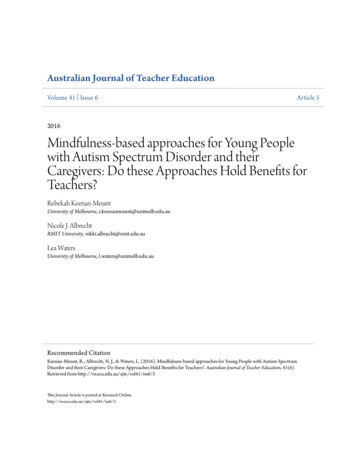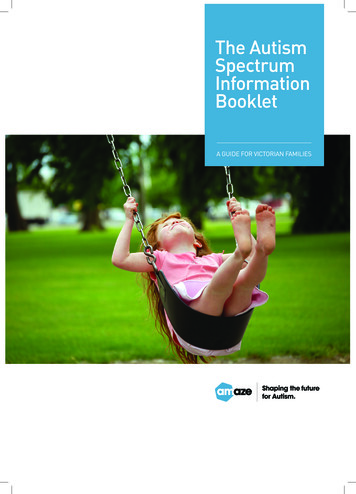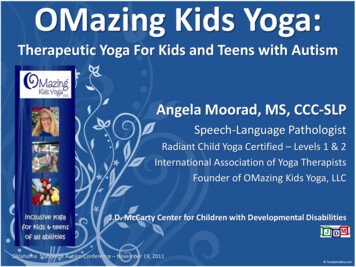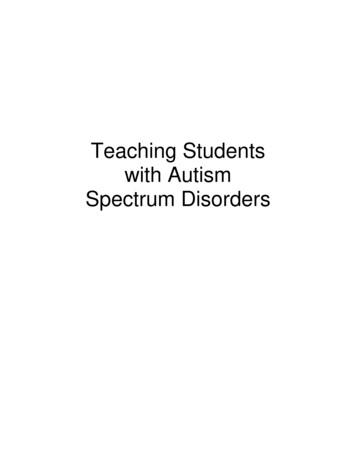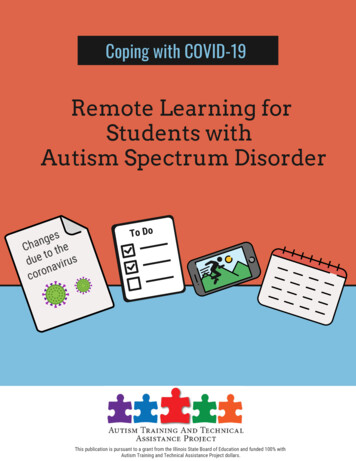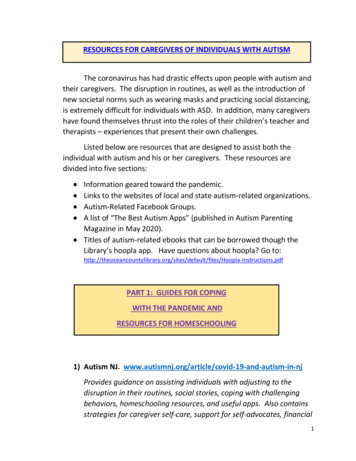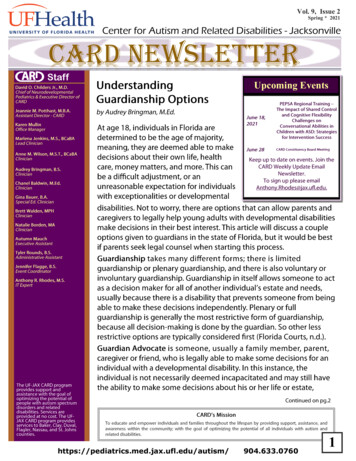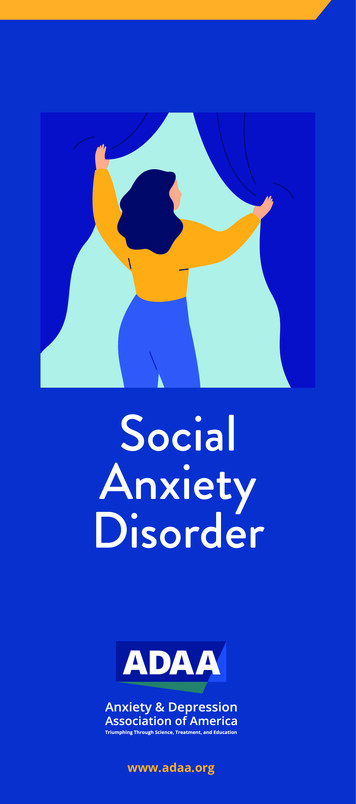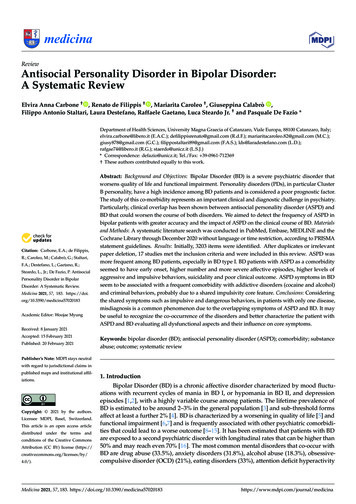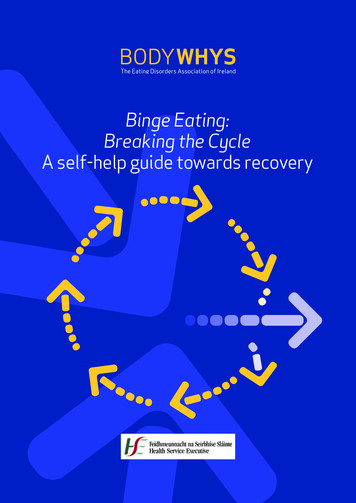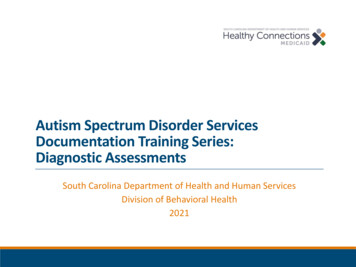
Transcription
Autism Spectrum Disorder ServicesDocumentation Training Series:Diagnostic AssessmentsSouth Carolina Department of Health and Human ServicesDivision of Behavioral Health2021
Disclaimer Materials presented today are not comprehensive.This training does not take the place of reading theprovider policy and procedure manual. Prior totreatment, all beneficiaries must meet the medicalnecessity criteria for that service. All information inthis presentation pertains to South CarolinaDepartment of Health and Human Services HealthyConnections (SCDHHS) Medicaid beneficiaries.2
Purpose of the Orientation To act as a guide for Autism Service Disorder (ASD)providers who are learning about South CarolinaMedicaid policy and procedures prior to renderingASD.oWhile this presentation is designed to enhanceunderstanding of the Medicaid Standards regarding theASD Policy Manual, all aspects and policy are not coveredin this presentation. Please review the ASD Manual andthe Administrative and Billing Manual. To help providers avoid potential Medicaidrecoupment.3
Documentation Training Series Comprehensive Psychological Assessment/TestingReport Behavior Identification Assessment Individualized Plan of Care Progress Summary Clinical Service Note ABA Prior Authorization General Information4
Objectives1. Review three different diagnostic assessmentsused to meet medical necessity criteria.2. Review the required components of eachdiagnostic assessment.3. Enable individuals to more confidently evaluatediagnostic assessments for required components.5
Comprehensive Psychological Assessments/TestingReportsThree Options:1.2.3.Definitive Diagnostic Assessment Completed BeforeJuly 1, 2017.Definitive Diagnostic Assessment Completed On orAfter July 1, 2017.Presumptive Diagnosis Completed Prior to aBeneficiary’s Fourth Birthday.6
Definitive Diagnostic Assessment Completed BeforeJuly 1, 2017Clinical ationThree ASDAssessments/Tools7
Clinical InterviewNarrative summary of meeting withbeneficiary/parent/caregiver that includes essentialbeneficiary information not otherwise captured in theassessments. This can include a brief overview, majorfindings, or discussion of the situation.8
Behavioral ObservationNarrative description of the behavior observed duringthe visit. This is typically a description of theindividual’s behavior in the room with the clinician orcaregiver before or after testing.9
Three Assessments or Diagnostic ToolsAt least three of the following, one of which must be anASD specific diagnostic tool*: Autism Diagnostic Observation Schedule (ADOS)*Autism Diagnostic Interview (ADI)*Childhood Autism Rating Scale (CARS)*Gilliam Autism Rating Scale (GARS)VinelandAssessment of Basic Language and Learning Skills (ABLLS)Social Responsiveness Scale (SRS)Behavior Assessment System for Children (BASC)Social Communication Questionnaire (SCQ)Standardized measure of intelligenceScreening Checklists (Modified Checklist for Autism inToddlers, Screening Tool for Autism in Toddlers, Ages & StagesQuestionnaires)10
Referral QuestionReason for the visit/evaluation.11
DiagnosisIncludes diagnosis from Diagnostic and StatisticalManual of Mental Disorders (DSM) to include one ofthe following: Autistic Disorder F84.1Asperger Syndrome F84.5Pervasive Developmental Disorder Not OtherwiseSpecified F84.9Childhood Disintegrative Disorder F84.312
Definitive Diagnostic Assessment Completed On orAfter July 1, 2017Diagnosiswith SeverityLevelStandardMeasure ofIntelligenceClinicalInterviewReview ofPresentingSymptomsADOSBehavioralObservation13
Clinical InterviewNarrative summary of meeting withbeneficiary/parent/caregiver that includes essentialbeneficiary information not otherwise captured in theassessments. This can include a brief overview, majorfindings, and discussion of the situation.14
Review of Presenting of ProblemsDescription of the problems, symptoms, or functionaldeficits that are the reason the beneficiary is beingevaluated. May also include strengths, history andpast psychological assessment reports and records.15
Behavioral ObservationNarrative description of the behavior observed duringthe visit. This is typically a description of theindividual’s behavior in the room with the clinician orcaregiver before or after testing.16
ADOSTest results and summary of ADOS.17
Standardized Measure of IntelligenceMust include one of the results and summary of the following: Wechsler Intelligence Scale for Children (WISC)Wechsler Adult Intelligence Scale (WAIS)Stanford-BinetBayley ScalesMullen Scales of Early LearningKaufman Brief Intelligence Test (KBIT-2)Developmental Profile (DP-3) if all five scales are used (physical,adaptive bx, social-emotional, cognitive & communication)Leiter International Performance ScaleComprehensive Test of Nonverbal Intelligence (CTONI-2)Universal Nonverbal Intelligence Test (UNIT-2)Wechsler Nonverbal Scale of Ability (WNV)Wechsler Preschool and Primary Scale of Intelligence (WPPSI)Differential Ability Scales (DAS-II)Battelle Developmental Inventory (BDI-2)18
ASD Diagnosis including Severity LevelsChecklist of DSM-5 ASD criteria, including severitylevels.19
Presumptive Diagnosis Completed Prior to aBeneficiary’s Fourth BirthdayClinicalInterviewReflects aPresumptiveDiagnosisObservation20
Reflects a Presumptive DiagnosisMay say “is at risk of autism” on the STAT or “ispresumptively diagnosed with autism.”21
ObservationThe diagnosing provider observed the beneficiary inat least one setting such as their office or clinic.22
Clinical InterviewInterview with the parents, guardians or othersignificant individuals involved in the child’s care.23
24
Leiter International Performance Scale Comprehensive Test of Nonverbal Intelligence (CTONI-2) Universal Nonverbal Intelligence Test (UNIT-2) Wechsler Nonverbal Scale of Ability (WNV) Wechsler Preschool and Primary Scale of Intelligence (WPPSI) Differential Ability Sc
